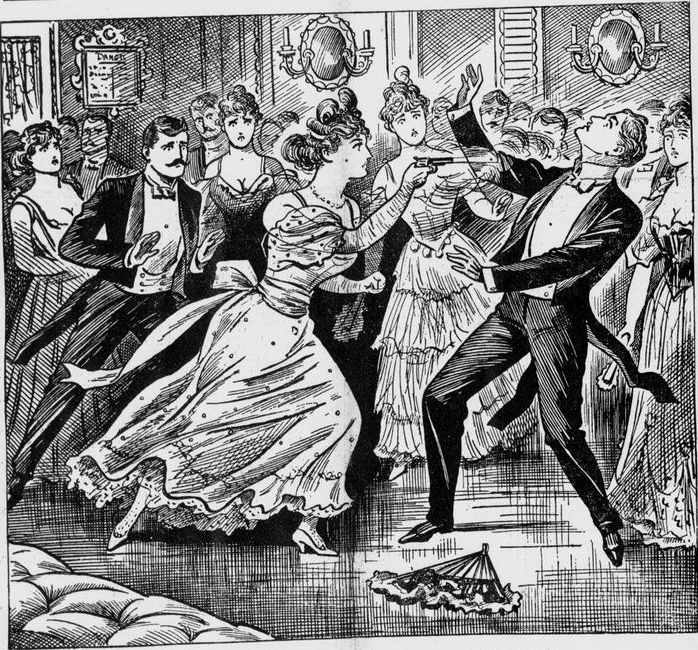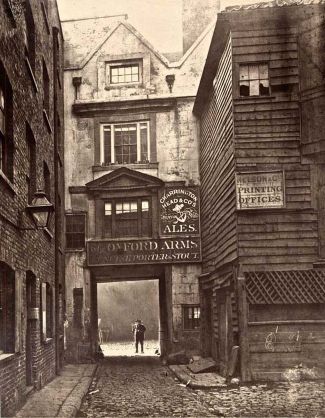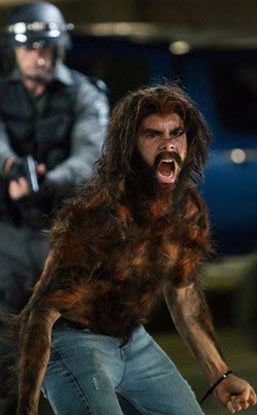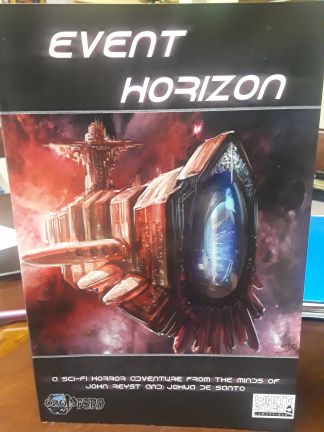
Event Horizon arrived yesterday. By John Reyst and Johua De Santo, this 59-page introductory adventure for White Star takes that game system into the realm of space horror, a genre that I’ve dug since seeing Alien in the theater way back in 1979.
I read the adventure last night. It hits many of the high points of space horror, and presents some really interesting gaming possibilities related to sanity (Sanity Events) and becoming unmoored in space-time (Time Dilation). Sanity Events come into two sizes: Minor and Major. The precise descriptions of Sanity Events are largely left up the GM. The module offers some suggestions to get the imagination working.
In game terms, Sanity Events cause a reduction of Wisdom. If Wisdom gets too low, the affected character becomes a dangerously unstable NPC. Time Dilation events unstick one or more characters from their present time and/or location. For example, a character may “flashback” to an earlier scene in the adventure or “jump” forward in time to experience something that might happen. Like with Sanity Events, examples and advice about Time Dilation effects appear throughout the module.
Without going into too much more detail about the adventure itself, it’s noteworthy that the scenario starts with new characters waking up from cryosleep after Bad Things have happened near a black hole. Event Horizon is a race against time that draws on elements from Alien, Pandorum, and the movie Event Horizon, among others. The characters must beat the clock, repairing their ship before it gets either sucked into a black hole or destroyed by alien invaders.
At first glance, Event Horizon is an attractive book. The cover and interior artwork is well-done, except for the pictures of the aliens, which still aren’t horrible. My aged eyes appreciate the single-column layout without obscuring background art or funky colors. I’d have used a different font for the headers, however; the header font in the book tricked my eyes into misreading a few words.
Similarly, while the ship’s maps are well done, the nebula background behind the maps is pretty but unnecessary, and the maps perhaps could been a bit larger. I found myself squinting at them, especially on the lower and middle deck maps where numbers appear in black over dark grey shading. In the main body of the adventure, italics are used to denote descriptive, read-aloud text, and these sections tend to blend into the main text. Boxed text or different spacing would have helped.

Most distracting, however, are the tables. Their layout is quirky, and some of the time text is missing. Table 5, for example, which uses 1d6, has results for 1, “3 thru 5”, and 6. Nothing for the number 2. (See the pic to right.) These details don’t ruin the look of Event Horizon, but they do distract from it as well as slightly muck up the coherence of the text.
All in all, however, I like Event Horizon, and I want to give it a run. I’d probably use Stars Without Number rather than White Star, since I prefer to form to the latter for sci-fi/space gaming, and that’s another selling point in favor of Event Horizon. It’s for White Star, but it’s still generic enough that Event Horizon would work well with just about old-school game.
Kudos to the d20pfsrd Publishing team!
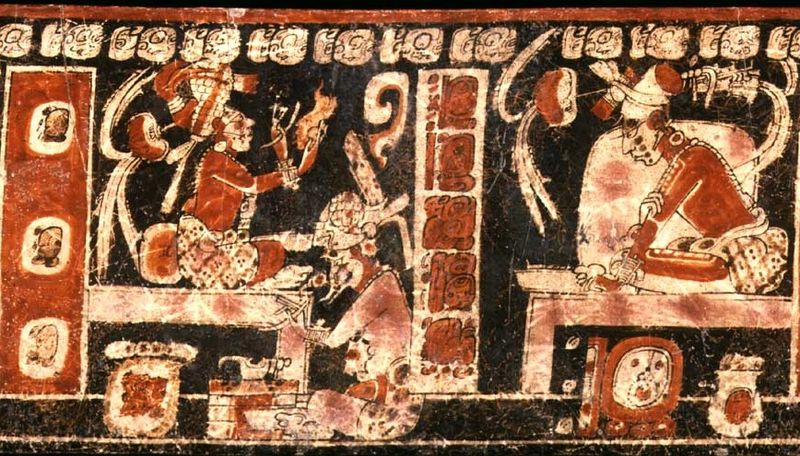
And now, as promised, the twin heroes Hunapu and Xbalanque converted the AD&D Deities & Demigods for use with 5E D&D.
Hunapu and Xbalanque were conceived when their mother Xquic, daughter of one of the lords of Xibalba, the rulers of the land of the dead, spoke with the severed head Hun, Xquic’s dead husband. The skull spat in Xquic’s hand, and the twins were conceived in her womb. Hunapu and Xbalanque are great adventurers and resolute foes of demons and the undead. Both men love games, especially competitive sports.
Hunapu & Xbalanque
Medium humanoid (human), lawful good
Armor Class 14 (20 with barkskin)
Hit Points 153 (18d8+72)
Speed 30 ft.
Ability Scores STR 22 (+6), DEX 18 (+4), CON 18 (+4), INT 16 (+3), WIS 12 (+1), CHA 18 (+4)
Saving Throws Strength +10, Dexterity +8, Intelligence +7, Wisdom +5
Skills Athletics +10, Investigation +11, Insight +9, Medicine +9, Perception +9, Survival +9
Damage Resistances cold, fire
Senses passive Perception 19
Languages Abyssal, Common, Infernal, Sylvan
Challenge 11 (7,200 XP)
Clever Minds. The twins make Intelligence and Wisdom saving throws with advantage. Their proficiency bonus for Intelligence and Wisdom skills is doubled.
Favored Enemies. The twins have advantage on Wisdom (Survival) checks to track fiends and undead. The twins also have advantage of Intelligence checks to recall information about fiends and undead.
Innate Spellcasting. Hunapu’s and Xbalanque’s innate spellcasting ability is Charisma (spell save DC 16). They can innately cast the following spells, requiring no material components:
1/day each: barkskin, call lightning, divination, freedom of movement, plant growth, spider climb
Legendary Resistance (3/Day). If either of the twins fails a saving throw, he can choose to succeed instead.
Magical Weapons. Hunapu’s and Xbalanque’s weapon attacks are magical.
Spellcasting. Hunapu and Xbalanque are 10th-level spellcasters. Their spellcasting ability is Intelligence (spell save DC 15, +7 to hit with spell attacks). They prepare spells from the druid and wizard spell lists, gaining the latter without need of a spellbook. Neither twin can prepare 5th-level wizard spells, but either may use a 5th-level slot to cast a lower level wizard spell. They have the following spells prepared:
Hunapu
Cantrips (at will): druidcraft, fire bolt, message, produce flame
1st level (4 slots): charm person, cure wounds, disguise self, jump
2nd level (3 slots): darkvision, pass without trace, phantasmal force
3rd level (3 slots): conjure animals, dispel magic, slow
4th level (3 slots): grasping vine, polymorph
5th level (2 slots): tree stride
Xbalanque
Cantrips (at will): guidance, message, prestidigitation, shocking grasp
1st level (4 slots): burning hands, cure wounds, grease, longstrider
2nd level (3 slots): blur, darkvision, spike growth
3rd level (3 slots): counterspell, haste, speak with plants
4th level (3 slots): conjure woodland beings, polymorph
5th level (2 slots): wall of stone
Wild Shape (2/Day). As a bonus action, a twin can magically assume the shape of a beast that has a challenge rating of 1 or lower that the twin has seen before. The twin can stay in a beast shape for 5 hours. He then reverts to his normal form unless he expends another use of this feature. He can revert to your normal form earlier by using a bonus action on your turn. He automatically reverts if he falls unconscious, drops to 0 hit points, or dies. While in beast form, the twins attacks count as magical for the purposes of overcoming resistance and immunity to nonmagical attacks and damage.
Actions
Multiattack. A twin makes three hand axe attacks, or one ranged weapon attack with a blowgun.
Hand Axe. Melee or Ranged Weapon Attack: +10 to hit, reach 5 ft. or range 20/60 ft., one target. Hit: 9 (1d6+6) slashing damage.
Blowgun. Ranged Weapon Attack: +8 to hit, ranged 150/600 ft., one target. Hit: 6 (1d4+4) piercing damage plus 21 (6d6) poison damage, and the target must succeed on a DC 17 Constitution saving throw or become poisoned for 1 minute. A target can repeat the saving throw at the end of each of its turns, ending the effect on itself on a success.
Reactions
Foe Slayer. When a fiend or undead creature within 5 feet of a twin hits or misses a twin with an attack, either twin can use his reaction to attack that creature immediately after its attack, provided the twin can see the creature.
Legendary Actions
Both Hunapu and Xbalanque can take 3 legendary actions each, choosing from the options below. Only one legendary option can be used at time and only at the end of another creature’s turn. The twins regain spent legendary actions at the start of their respective turns.
Detect. The twin makes a Wisdom (Perception) check or a Wisdom (Insight) check.
Move. The twin moves up to half his speed without provoking opportunity attacks.
Tackle. The twin makes a Strength (Athletics) check against an adjacent creature contested by the creature’s Strength (Athletics) or Dexterity (Acrobatics) check. If the twin wins the contest, he either knocks the target prone or pushes it 5 feet away from him. In either case, the target takes 8 (1d4+6) bludgeoning damage.
Tags: 5E D&D, Deities & Demigods, horror, NPCs, reviews
